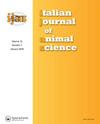Effects of partially defatted larvae meal of Black Soldier Fly ( Hermetia illucens ) on caecal microbiota and volatile compounds of Muscovy ducks ( Cairina moschata domestica )
IF 2.3
3区 农林科学
Q1 AGRICULTURE, DAIRY & ANIMAL SCIENCE
引用次数: 0
Abstract
The present study explored the effects of substituting maize gluten meal with increasing levels of partially defatted black soldier fly larvae meal (BSFLM) in Muscovy ducks’ diets on their caecal microbiota and organic volatile compounds. The ducks were divided into four groups, each receiving a diet containing 0%, 3%, 6%, or 9% BSFLM (HI0, HI3, HI6, and HI9, respectively). At slaughter (50 days of age), caecal samples were collected and analysed. The alpha diversity indexes were lower in the HI9 than in the HI0 and HI3 treatments that did not differ between them. Bacteroidetes in the HI0 and Firmicutes in the HI6 treatment showed a higher abundance than in the HI9 treatment. Faecalibacterium and Megamonas were more abundant in the HI6 than in the HI9 treatment. Abundance of Clostridium and unclassified Coriobacteriaceae were higher and lower, respectively, in the HI9 than in the HI0 treatment. Canonical discriminant analysis revealed that Faecalibacterium, unclassified Victivallaceae and Megamonas in relation to Ruminococcus would separate the HI6 and HI9 treatments, while unclassified Coriobacteriaceae in relation to Streptococcus and Faecalibacterium would distinguish the HI0 and HI3 from the HI6 and HI9 treatments. Eleven volatile compounds were more abundant HI9 than in the HI6 treatment. Five of them were negatively correlated with Faecalibacterium and two with Megamonas. These findings indicate that diets with 6% and 9% BSFLM alter the caecal microbiota in Muscovy ducks, while a diet with 3% BSFLM has no effect. The distinct abundance of several volatile compounds in the 6% and 9% BSFLM treatments suggests a relationship between their characteristic microbiota profile and those compounds that warrants further investigation.黑兵蝇部分脱脂幼虫饲料对番鸭盲肠菌群和挥发性化合物的影响
本研究旨在探讨在番鸭日粮中添加部分脱脂黑虻幼虫粉(BSFLM)替代玉米蛋白粉对其盲肠菌群和有机挥发性化合物的影响。各组分别饲喂含0%、3%、6%和9% BSFLM (HI0、HI3、HI6和HI9)的饲粮。在屠宰时(50日龄),收集并分析盲肠样本。HI9处理的α多样性指数低于HI0和HI3处理,但两者之间没有差异。HI0和HI6处理的厚壁菌门中拟杆菌门的丰度高于HI9处理。粪杆菌和巨单胞菌在HI6处理中比在HI9处理中更丰富。与HI0处理相比,HI9处理中梭状芽孢杆菌和未分类的科里杆菌科的丰度分别较高和较低。典型判别分析表明,Faecalibacterium、未分类的Victivallaceae和与Ruminococcus相关的Megamonas能够区分HI6和HI9处理,而与Streptococcus和Faecalibacterium相关的未分类的Coriobacteriaceae能够区分HI0和HI3与HI6和HI9处理。11种挥发性化合物的HI9含量高于HI6处理。其中5个与粪杆菌呈负相关,2个与巨单胞菌呈负相关。上述结果表明,饲粮中添加6%和9%的BSFLM可改变番鸭盲肠菌群,而饲粮中添加3%的BSFLM对番鸭盲肠菌群没有影响。在6%和9%的BSFLM处理中,几种挥发性化合物的明显丰度表明,它们的特征微生物群特征与这些化合物之间存在关系,值得进一步研究。
本文章由计算机程序翻译,如有差异,请以英文原文为准。
求助全文
约1分钟内获得全文
求助全文
来源期刊

Italian Journal of Animal Science
农林科学-奶制品与动物科学
CiteScore
4.90
自引率
8.00%
发文量
141
审稿时长
18-36 weeks
期刊介绍:
The Italian Journal of Animal Science is an international peer-reviewed open access journal publishing original scientific papers, reviews and short communications on animal science, animal production and related areas. The journal welcomes submissions on the following subjects:
• Animal derived food quality and safety
• Animal genetics and breeding
• Aquaculture, poultry, companion and wildlife
• Livestock systems, management and environment
• Non-ruminants nutrition and feeding
• Production physiology and biology
• Ruminants nutrition and feeding
Announcements of congresses, presentations of universities, research institutes, books and proceedings may also be published, as well as news regarding the members of the Animal Science and Production Association (ASPA). The Association will be glad to receive proposals for your admission as an ordinary or corresponding member: please read regulations and procedures in the statute of the ASPA .
 求助内容:
求助内容: 应助结果提醒方式:
应助结果提醒方式:


